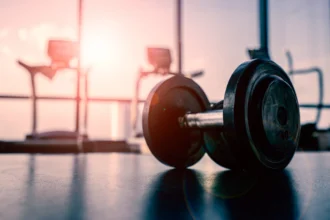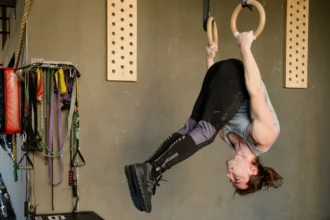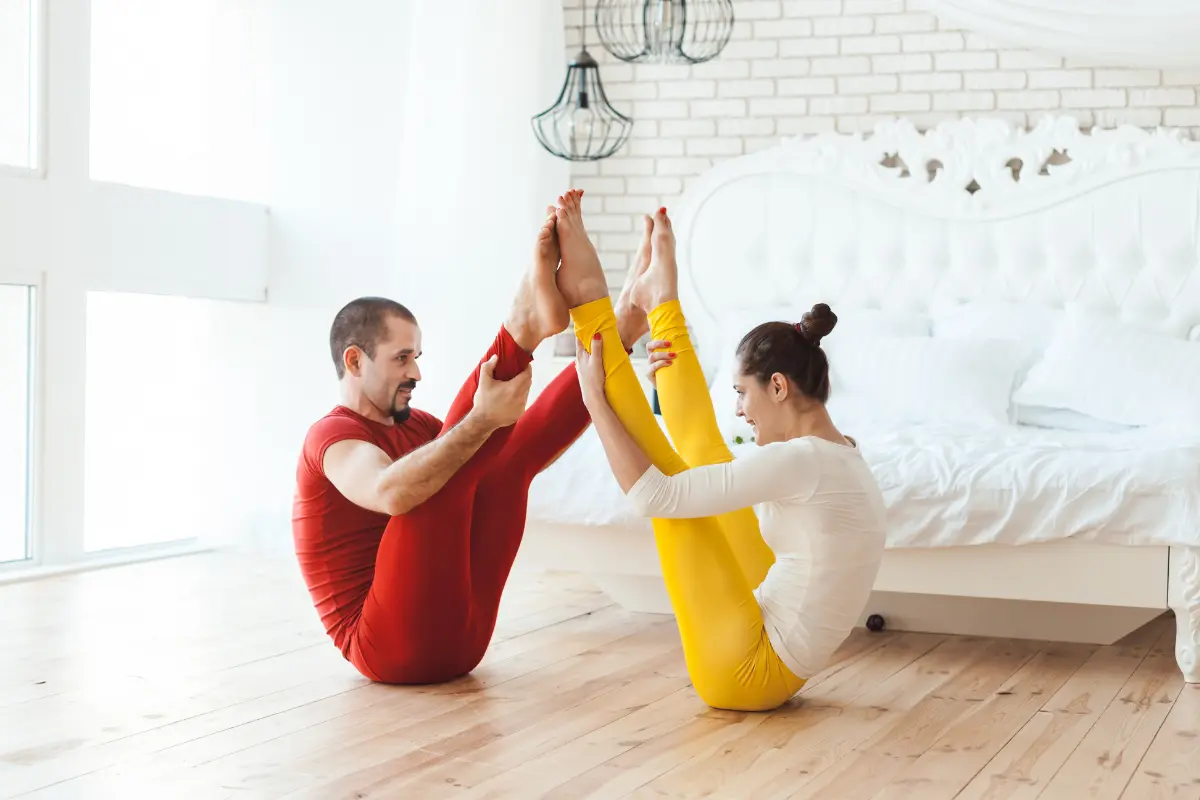Gymnastics features different events for men and women, each designed to highlight their unique strengths. While some events are shared, most are gender-specific, reflecting the physical differences between male and female athletes.
In this article, we’ll explore why men and women compete in different gymnastics events.
A Brief History of Gymnastics
Gymnastics as a competitive sport dates back to ancient Greece, where it was part of the Olympic Games. Initially, the events were primarily male-dominated, reflecting the societal norms of the time. Women were largely excluded from many sports competitions, including gymnastics, until the late 19th century.
In the 19th century, gymnastics began to gain popularity across Europe. However, women’s participation was initially limited to display and exhibition events, rather than competitive routines. It wasn’t until the 20th century that women began to compete in gymnastics in a formalized way, leading to the creation of different event categories.
Physiological Considerations
While historical and cultural factors played a major role in shaping the events for each gender, physiological differences also contributed to why certain events are better suited to men and others to women. The key differences between male and female athletes in gymnastics are related to muscle mass, body structure, flexibility, and strength.
1. Muscle Mass and Strength
Men generally have a higher proportion of muscle mass, especially in the upper body. This difference is particularly relevant in events like the rings, which require considerable upper-body strength to perform static holds, swings, and complex routines.
Events like the pommel horse also rely heavily on upper body strength and endurance. These physical demands make it more challenging for women, who tend to have less upper body strength on average, to compete in these events at the same level as men.
2. Flexibility and Balance
Women generally have greater flexibility, especially in their hips and lower body, which benefits events like the balance beam and uneven bars.
The beam, in particular, requires exceptional balance, flexibility, and poise, qualities that women often excel in due to their flexibility advantages. The uneven bars also demand a high degree of flexibility, along with the ability to perform graceful, flowing movements, an area where women’s bodies tend to have a mechanical advantage.
3. Body Composition
Women’s lower body tends to be more flexible than men’s, which allows for easier movement through splits, jumps, and turns that are common in floor routines.
The combination of flexibility, agility, and a focus on artistic performance makes floor exercise an event where women traditionally excel. Men, on the other hand, have more upper body mass, giving them an advantage in strength-heavy events like rings and pommel horse.
Breaking Down Gender-Specific Events in Gymnastics
Men’s and women’s competitions differ in several apparatuses, with each designed to highlight gender-specific attributes such as strength, flexibility, and grace.
Men’s Artistic Gymnastics (MAG)
Men compete in six events:
- Floor Exercise
- Pommel Horse
- Still Rings
- Vault
- Parallel Bars
- Horizontal (High) Bar
Women’s Artistic Gymnastics (WAG)
Women compete in four events:
- Vault
- Uneven Bars
- Balance Beam
- Floor Exercise
Each apparatus in gymnastics is meticulously designed to complement the athlete’s physical capabilities and to emphasize particular skills. Here’s an overview of the gender-specific events and the reasons behind their design.
1. Uneven Bars (Women Only)
The Uneven Bars consist of two horizontal bars set at different heights and widths, designed to highlight fluidity, grace, and artistic transitions.
- High Bar: Positioned approximately 250 cm (8.2 feet) above the floor.
- Low Bar: Positioned approximately 170 cm (5.6 feet) above the floor.
- Bar Material: Typically fiberglass with a wood veneer, offering flexibility and grip.
Why Men Don’t Do Uneven Bars
The uneven bars are designed specifically with female physiology in mind. The narrower bar diameter and differing height positions are ideal for women’s generally smaller hands and lighter body types.
The routines prioritize fluid transitions, release moves, and intricate handstands—skills that are more aligned with artistic expression than strength. Men’s gymnastics, which places a greater emphasis on raw strength and power, favors apparatuses like the high bar, where the focus is on swinging, strength holds, and acrobatic dismounts.
Some of the elements of swinging and release moves on the uneven bars already exist in men’s High Bar routines. Thus, adding an uneven bars event in the men’s competition would be redundant, as it would overlap with skills performed on the high bar.
2. Parallel Bars (Men Only)
The Parallel Bars consist of two horizontal bars placed at equal height, set about shoulder-width apart.
- Height: Approximately 200 cm (6.56 feet) above the floor.
- Width: The distance between the bars is adjustable from 42 cm to 52 cm (16.5 to 20.5 inches).
Why Women Don’t Do Parallel Bars
The parallel bars require significant upper body strength to perform skills like swings, holds, and releases. While women are incredibly strong, men’s generally larger upper bodies and greater muscle mass (due to higher testosterone levels) provide them with a physiological advantage in executing these demanding moves.
Historically, women’s gymnastics evolved with an emphasis on grace, artistry, and flexibility, while men’s gymnastics focused more on power and strength. The parallel bars, which have military and strength-training roots, were not seen as a suitable apparatus for the artistic style of women’s routines.
3. Pommel Horse (Men Only)
The Pommel Horse is a cylindrical apparatus with two handles (pommels) on top, used for a combination of swings, rotations, and strength holds.
- Height: Approximately 105 cm (3.44 feet).
- Length: About 160 cm (5.25 feet).
- Width: The body is around 35 cm (13.8 inches) wide.
Why Women Don’t Do Pommel Horse
The pommel horse is an apparatus that requires continuous movement, balance, and precision. The height of the apparatus, optimized for men’s average height, could present difficulties for women, who tend to be shorter.
The routines performed on the pommel horse—scissors, flairs, and swings—require significant upper body strength and control. Men’s greater upper body strength and size make them more suited to these physical demands. Women, on the other hand, typically find it more challenging to meet the rigorous strength and coordination required for pommel horse routines.
4. Balance Beam (Women Only)
The Balance Beam is a narrow, horizontal apparatus where gymnasts perform a routine involving jumps, turns, and acrobatic elements.
- Length: 5 meters (16 feet).
- Width: 10 cm (4 inches).
- Height: 1.25 meters (4.1 feet) above the floor.
Why Men Don’t Do Balance Beam
Balance beam routines emphasize artistry, flexibility, and dance-like movements—elements that are highly valued in women’s gymnastics but less so in men’s routines.
The narrow width of the beam (only 10 cm) presents a unique challenge, requiring absolute control and precision. While male gymnasts do excel in balance, the narrower beam is often less suited to their typically larger feet and body sizes. The beam’s aesthetic and artistic nature, focused on grace and expression, aligns more with women’s gymnastics, where artistry plays a larger role in scoring.
5. Still Rings (Men Only)
The Still Rings are one of the most physically demanding events in gymnastics, requiring gymnasts to perform a variety of static holds, swings, and strength elements while maintaining control over the swinging rings.
- Height: 2.75 meters (approximately 9 feet).
- Ring Diameter: 18 cm (about 7 inches).
- Ring Distance: 50 cm (approximately 20 inches) apart.
Why Women Don’t Do Still Rings
The Still Rings require immense upper body and core strength, particularly in the shoulders, wrists, and elbows. Men’s generally larger joints and stronger upper bodies are better suited to withstand the stresses and intense strength holds required in ring routines.
Women, on average, may have less upper body muscle mass and joint strength, which makes the still rings a less appropriate apparatus for women’s gymnastics.
Shared Events: Vault and Floor Exercise
While most gymnastics events are gender-specific, there are some shared events where the apparatus and execution differ slightly between men and women.
Vault
Both men and women perform the vault, but the vault table is set at different heights for each gender.
Men’s Vault: Higher Heights and More Difficult Skills
One major difference is the height of the vaulting table. For men, the table is set at 1.35 meters (4 feet 5 inches), while for women, it is set at 1.25 meters (4 feet 1 inch). This higher height for men requires more strength and power to generate the lift needed to perform the vaults.
Men also perform more complex vaults. For example, vaults like the handspring double vault or Sukahara double back—which involve multiple flips and twists—are common in men’s competitions.
Men’s Vault: Higher Heights and More Difficult Skills
One major difference is the height of the vaulting table. For men, the table is set at 1.35 meters (4 feet 5 inches), while for women, it is set at 1.25 meters (4 feet 1 inch). This higher height for men requires more strength and power to generate the lift needed to perform the vaults.
Men also perform more complex vaults. For example, vaults like the handspring double vault or Sukahara double back—which involve multiple flips and twists—are common in men’s competitions.
In men’s vaulting, gymnasts are scored on both difficulty and execution. A gymnast can earn a higher score by performing a more challenging vault, provided the execution is nearly perfect. The complexity of the vault plays a huge role in the final score.
Women’s Vault: Impressive but Less Complex
In comparison, women tend to perform less complex vaults. Most female gymnasts opt for moves like the Yurchenko or handspring vaults, which typically involve one flip or twist. While these vaults still require a great deal of power and skill, they are generally simpler than the double twists or multiple flips seen in the men’s competition.
The reason for this difference is largely due to safety concerns. Female gymnasts generally don’t attempt the more complicated vaults because of the risk of injury, especially given the transition from the vaulting horse (used in the past) to the modern vaulting table.
That said, women’s vaults are still incredibly difficult. Female gymnasts must maintain speed, power, and precision while focusing on clean form and perfect landings. For example, the Amanar vault, which involves a double twist and back handspring, is considered one of the most difficult vaults in women’s gymnastics.
Floor Exercise
The floor exercise is one of the most exciting events in gymnastics, but it differs between male and female athletes.
Women’s Floor: Dance and Artistic Expression
One key difference is that women compete to music. Their routines combine dance, jumps, leaps, and tumbling, with the dance elements being a major part of the performance. Judges not only look at the acrobatic skills but also at how well the gymnast expresses herself, how the movements flow, and how the choreography matches the music.
For women, the floor exercise is about more than just strength. It’s also about showing grace, rhythm, and an emotional connection to the music. The routine includes leaps and jumps that test flexibility and balance. The choreography has to flow smoothly, making it a true test of both athleticism and artistry.
Women’s Floor: Dance and Artistic Expression
One key difference is that women compete to music. Their routines combine dance, jumps, leaps, and tumbling, with the dance elements being a major part of the performance.
Judges not only look at the acrobatic skills but also at how well the gymnast expresses herself, how the movements flow, and how the choreography matches the music.
For women, the floor exercise is about more than just strength. It’s also about showing grace, rhythm, and an emotional connection to the music. The routine includes leaps and jumps that test flexibility and balance. The choreography has to flow smoothly, making it a true test of both athleticism and artistry.
What’s The Difference Between Men’s And Women’s Gymnastics?
The main difference between men’s and women’s gymnastics is the events they compete in. Men have six events: floor, pommel horse, rings, vault, parallel bars, and high bar, which focus more on strength and acrobatics. Women, on the other hand, have four events: vault, uneven bars, balance beam, and floor, which emphasize grace, balance, and flexibility.
Is Men’s Gymnastics Harder Than Women’s?
Both men’s and women’s gymnastics are incredibly demanding, but they challenge athletes in different ways.
Men’s gymnastics may be considered “harder” in terms of pure strength and power, especially on events like rings and pommel horse. Women’s gymnastics, however, is no less difficult, as it demands a combination of flexibility, balance, artistic expression, and explosive power, particularly in events like balance beam and floor exercise.
In short, it’s not a straightforward comparison — they challenge athletes differently. Both require years of training, exceptional skill, and immense dedication.
Why Do Men Have More Events Than Women in Gymnastics?
Women compete in four events, while men compete in six events. The design of gymnastics events is closely tied to the physical attributes and historical evolution of each gender’s participation in the sport.
Despite the growing strength and complexity of women’s routines, the number of events for women has remained fewer than for men due to longstanding traditions and the evolution of the sport. The fewer events in women’s gymnastics allow for more time to focus on precision and artistry in each apparatus, which are central to their performances.
In the end, the difference in events between men’s and women’s gymnastics comes down to history, tradition, and the physical demands of the sport. These differences, shaped over time, reflect the unique physical attributes and skills required for each gender.





